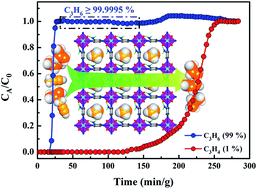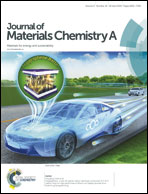Fine-tuning of nano-traps in a stable metal–organic framework for highly efficient removal of propyne from propylene†
Abstract
Despite tremendous efforts, precise control in the synthesis of porous materials with ideal nanocages for desired gas separation applications still remains a challenge. Microporous metal–organic frameworks (MOFs) have provided rich chemistry to enable precise control and design of structures, pore cavities, and functionalities at the molecular level. Here, we propose and design a microporous MOF (termed as ZJUT-1, ZJUT = Zhejiang University of Technology) with a fine-tuned nanocage, exhibiting the desired size, shape, and functionalities that are suitable for trapping a single propyne (C3H4) molecule. Adsorption and computational studies indicate that such optimized nanocages can not only reduce the uptake of propylene (C3H6), but also strengthen the C3H4–host interactions through multiple hydrogen-bonding between SiF62−/–NH2 and C3H4 molecules. This material thus shows remarkably different C3H4 and C3H6 adsorption capacities, with the largest uptake ratio of 3.06 at 1 bar and 298 K, affording a very high selectivity (up to 70) for C3H4/C3H6 (1/99) separation. The actual breakthrough experiments demonstrate that ZJUT-1 can efficiently remove trace amounts of C3H4 from the important raw C3H4/C3H6 mixtures under ambient conditions with 0.19 mmol g−1 C3H4 uptake capacity to produce 99.9995% pure C3H6.

- This article is part of the themed collection: Industry R&D collection


 Please wait while we load your content...
Please wait while we load your content...